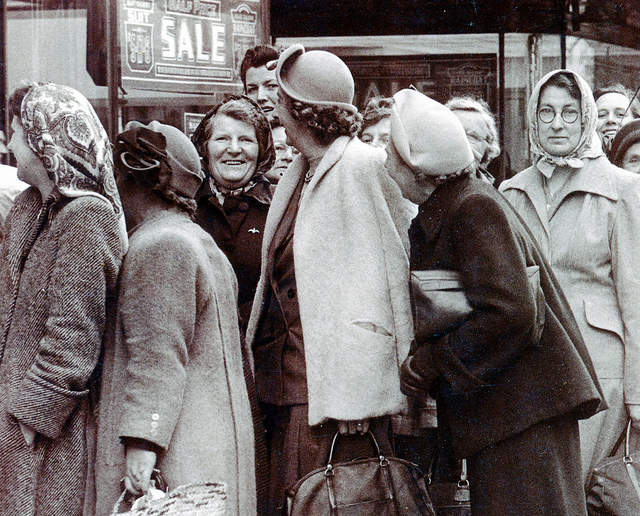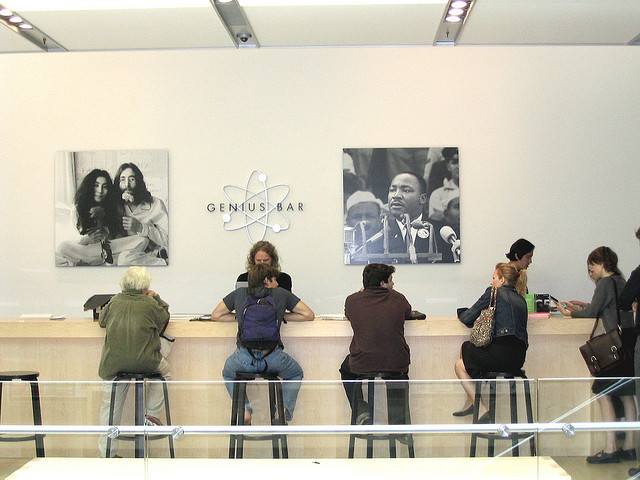Unlock the Magic in Your Story Now
Get the Free 20 questions to Ask Before Launching Your Idea workbook when you sign up for occasional updates.
Get the Free 20 questions to Ask Before Launching Your Idea workbook when you sign up for occasional updates.
Where Are The Holes?
filed in Marketing, Storytelling, Strategy
 It’s hard to be objective when you evaluate your competitors. When you’re feeling vulnerable there is a tendency to think about all of the things your competitors are doing right and how you don’t measure up against them.
It’s hard to be objective when you evaluate your competitors. When you’re feeling vulnerable there is a tendency to think about all of the things your competitors are doing right and how you don’t measure up against them.
The irony is that opportunities are realised and groundbreaking ideas are brought to life by doing exactly the opposite.
Great entrepreneurs look at all the ways the competition isn’t measuring up and find opportunities where gaps exist. This is how brands like Virgin, Huffington Post and iTunes came to be.
There is no one better placed than you to see what the others have missed.
Consider how the competition is failing to measure up? How could you change things?
Now go change things—then show people what you changed and why.
Image by Cynthia Smoot.
Share this article
What if?
filed in Entrepreneurship

What if I don’t do what the bus driver says?
What if sharing my dream makes people believe the impossible is possible?
What if there were no buttons?
What it we made the wallet disappear?
What if the ‘one more thing’ changed everything?
What if we taught our kids how to lose?
What if this is the first link in a chain that never breaks?
What if this moment helps someone to see?
What if three words gave people the courage to question the answer?
What if the thing my brain convinces me to run from, is the reason I’m here?
What if today is the last time I get to make change?
What if we each acted as if?
Image by Chris Green.
Share this article
The New Consumer Relationship
 In the days before self-service shopping and before every home had a fridge, the responsibility for daily grocery shopping fell to women. The consumer was someone who came to passively buy what was on offer. While a 1955 focus group could persuade Birdseye to make fish fingers from cod rather than herring—that was where the partnership ended, until housewives voted with their shillings and cents. Their purchases were dictated by availability and trends, their choices heavily influenced by advertising and restricted by weekly budgets.
In the days before self-service shopping and before every home had a fridge, the responsibility for daily grocery shopping fell to women. The consumer was someone who came to passively buy what was on offer. While a 1955 focus group could persuade Birdseye to make fish fingers from cod rather than herring—that was where the partnership ended, until housewives voted with their shillings and cents. Their purchases were dictated by availability and trends, their choices heavily influenced by advertising and restricted by weekly budgets.
Today though, our customers have become more than just consumers of our products and services. They are partners, co-creators, patrons, advocates, evangelists, collaborators and community members. People no longer just want to buy things from us without thinking, they want to become invested in the businesses and brands that they choose to support.
This is a shift we can and should nurture, not to mention an opportunity we can leverage.
How is your business doing that?
Image by Paul Townsend.
Share this article
What Lens Do You Use?
filed in Marketing, Storytelling, Strategy
 I’m a huge fan of Human’s of New York. It’s the kind of generous and rare content on the Internet that makes you grateful, sad and optimistic all at once.
I’m a huge fan of Human’s of New York. It’s the kind of generous and rare content on the Internet that makes you grateful, sad and optimistic all at once.
Brandon (lying down in the photo above because he is 6’4″ and always wants to get down to the level of his subject), will happily tell you that he isn’t the best photographer in the world. His gift is his ability to really see people—to connect with them and earn their trust in a couple of minutes. What makes Brandon’s blog and book compelling is that he sees what others overlook and can tell a story that engages emotionally, one that reflects back to us who we are when we are at our best.
I adore my friend Sneh’s cooking blog. Her love of food and nourishing people shines through in every image. Each one makes me want to head to the kitchen to start sifting flour and cubing butter.
Brandon’s and Sneh’s work is a gift that can’t easily be replicated because of how they put themselves into it. But one question that I see people asking often in their blog comments is, “What lens do you use?”
It’s not the tools that matter, it’s the intention with which you use them. It’s how you see the world and the people you choose to serve. It’s why you show up and how much of yourself you put into the work that matters.
When you do that (whatever size your company is) your business model becomes impossible to replicate.
Image by Nathan Congleton.
Share this article
Two Simple Questions Most Content Marketers Forget To Ask
 For fifty years marketing was all about pushing. We used advertising to get us closer to our end goal—which was more sales. Today marketing is more about drawing people closer. We use content (amongst other things) to help us build relationships with potential customers. And yet sometimes we forget that we’re no longer marketing like it’s 1969.
For fifty years marketing was all about pushing. We used advertising to get us closer to our end goal—which was more sales. Today marketing is more about drawing people closer. We use content (amongst other things) to help us build relationships with potential customers. And yet sometimes we forget that we’re no longer marketing like it’s 1969.
The goal for content marketing cannot always be to get people to buy more today, but every piece of content should still have a purpose.
Two questions to ask before you write you next blog post
….add a photo to your Instagram feed, update to your Facebook page, record your latest podcast or shoot that new YouTube video.
1. How do I want my reader/listener/follower to feel?
2. What do I want her to do next?
When you care enough to make every piece of content valuable, people will know.
Image by Grimme.
Share this article
How Are You Creating Value?
 Think about your favourite airline or a product you use every day and the supermarket you feel most comfortable shopping at. Now think about why you keep going back. What is it that this business delivers? The airline most likely sells similar seats, with average legroom, at around the same price as their competitors. The product you love probably doesn’t have more features than another leading brand’s. The supermarket stocks many of the same things as the one at the other end of the street.
Think about your favourite airline or a product you use every day and the supermarket you feel most comfortable shopping at. Now think about why you keep going back. What is it that this business delivers? The airline most likely sells similar seats, with average legroom, at around the same price as their competitors. The product you love probably doesn’t have more features than another leading brand’s. The supermarket stocks many of the same things as the one at the other end of the street.
And yet somehow this business or brand gave you reasons to choose them.
Try this….pick one brand, cafe, app or store that you wouldn’t want to live without and make a list of the reasons why. Now stand in your customer’s shoes and make that same list for whatever you sell, design, develop or serve.
How are you creating value beyond components, ingredients, features and benefits that your competitors could copy tomorrow? Your competitive advantage may not be as limited as you think.
Image by Unsplash.
Share this article
Who Is Responsible For Seeing Your Customers?
 When I worked in the stock control department at Tesco thirty years ago, I was partly responsible for making sure there were enough tins of soup available to be bought by the customers who would walk up and down those supermarket aisles the following week. There were people in charge of making sure that shelves were full and others to process customers efficiently through checkouts. There was a girl who manned the customer service counter. Her job it seemed was to offer practiced and polite responses to disgruntled customers along with their refunds.
When I worked in the stock control department at Tesco thirty years ago, I was partly responsible for making sure there were enough tins of soup available to be bought by the customers who would walk up and down those supermarket aisles the following week. There were people in charge of making sure that shelves were full and others to process customers efficiently through checkouts. There was a girl who manned the customer service counter. Her job it seemed was to offer practiced and polite responses to disgruntled customers along with their refunds.
Later, when I managed a cafe the boss told me that I was responsible for opening the door at 7am, for making sure that we had enough staff on duty and that the till wasn’t short at the end of the day. There was a girl in charge of buttering bread and cutting up lemon meringue pies into exactly twelve slices and someone to take pound notes from customers for the afternoon tea and cake special during that dead period after 3pm.
Customers came, were served, spent and went. In both businesses there were metrics for efficiency—boxes to be ticked that had implications on balance sheets. If the store didn’t run out of tins of Campbell’s tomato soup, the register balanced and sales trended up, apparently you won.
But there were no metrics around the most important job of all—that of seeing the customer.
Nobody at Tesco was obliged to care about the old lady who couldn’t reach the tins on the high shelf. We were not supposed to notice how she did a mental calculation of the contents of her basket before she got to the checkout to save being embarrassed if she was short by a few pence.
And as long as the twelve pieces of pie at the cafe were sold by closing time it didn’t matter who had bought and paid for them. Never mind that each piece represented a student at the university across the road eking out his grant on the afternoon special, or a young mother sheltering from a downpour with her crying baby.
When we offer service, by definition the minimum requirement is that we are useful to people. But how can we truly serve people if we don’t know who they are? How can we give them what they want if we don’t make the effort to see them?
The businesses that have been runaway successes over the past three decades (since I gave up counting tins for Tesco), are the ones that have taken the time to really see their customers and then to design metrics around serving them based on what they see. The Zappos, Apples (from Geniuses to engineers) and Patagonias of this world make someone responsible for seeing, not just serving their customers. Who is responsible for seeing yours?
Image by John Haslam.
Share this article
Lessons In Non-Profit Storytelling From The Best In The World
filed in Marketing, Storytelling, Strategy
 If you think times are tough in a marketing world where you’re actually providing goods or services in exchange for money, spare a thought for the marketers of charities who need to convince us to part with money without wrapping up something for us to take home.
If you think times are tough in a marketing world where you’re actually providing goods or services in exchange for money, spare a thought for the marketers of charities who need to convince us to part with money without wrapping up something for us to take home.
One of the biggest challenges non-profits face is justifying their operating costs. Supporters of charities have long questioned the amount of money spent on admin vs. how much actually creates impact for the worthy cause they donated to.
The Internet has made it easier for charities to reach people and to tell their story, but that access has also created a new breed of supporter who is both savvy and discerning. Access shouldn’t be confused with impact though. There are no shortcuts to mattering to people, but there are ways you can tell a better brand story.
7 Lessons In Non-Profit Marketing From charity: water
1. Declare a single enemy.
charity: water’s is dirty water. They explain how lack of access to clean drinking water impacts everything from health to time, poverty to education and the effect on the lives of women and children in particular.
2. The 100% giving model.
Build trust with transparency. charity: water stripped away all doubt about how much of the donated funds actually impacted good causes. They have two funding streams, donations to water projects from supporters and private donors and sponsors who fund operating costs. Donations are tracked to results in the field using photos and GPS so that supporters can see their impact.
3. Provide context
The size of the problem is still big (a billion people don’t have access to clean water), but charity: water breaks it down. They make the real impact of the donation more tangible.
My $20 buys access to clean water for one person.
4. Understand the donor’s worldview.
charity: water knows that we were buying the feeling that giving brings.
They worked out what supporters needed to know and how they wanted to feel and used great storytelling to make that happen.
5. Make it personal
The my charity: water platform gives people the opportunity to create their own campaign and a way to reach out to and connect with their supporters. This platform also makes it easy to both fundraisers and supporters to donate, keep track of progress and feel involved.
There are regular campaigns encouraging people to ‘donate’ their celebrations, like birthdays to the cause.
6. Leverage design.
Take a look at the charity: water website and you’ll see what I mean. Many charity websites feel clunky, they often have the feel of a dated corporate bureaucracy. This one feels like it’s alive, that it’s powered by community and intention, that work being done. The charity also has a recognisable symbol— the yellow jerry can.
7. Create community
charity: water makes it easy to share their story and your campaign via social media. They leverage all of the modern brand storytelling tools to both share the joy and create a sense of community.
Here is the charity: water Difference Map (created by me for the book Difference, not in consultation with charity: water). It might give you some clues about how to tell your own story.
Share this article
How Great Products Are Born, Not Made
filed in Marketing, Storytelling, Strategy
 When you’re designing a product or service it’s easy to believe that making it the best in the world is what gives you a competitive advantage. But the thing about ‘best’ is that it’s subjective. ‘Best’ isn’t determined by you, it’s your customers and users who decide. The truth is that people don’t fall in love with the best product. They fall in love with the product that delivers the experience and the feeling that they want.
When you’re designing a product or service it’s easy to believe that making it the best in the world is what gives you a competitive advantage. But the thing about ‘best’ is that it’s subjective. ‘Best’ isn’t determined by you, it’s your customers and users who decide. The truth is that people don’t fall in love with the best product. They fall in love with the product that delivers the experience and the feeling that they want.
What makes the apps we use daily, the restaurants we keep going back to and the brands we wouldn’t dream of switching from a success? It turns out that great products and services are born from obsessing about the user’s feelings and frustrations, from understanding the problem to solve, for whom and knowing why it matters to them. Great innovations and experiences are not made by focusing on form and functionality without caring about the context in which people with an actual problem will use and benefit from them.
People don’t want a better knife, they want the butter on their bread.
Image by Tito Perez.
Share this article
How To Be Different
filed in Marketing, Storytelling, Strategy
 When Apple and Microsoft went head-to-head Apple didn’t ask, “How can we be different from Microsoft?” No, the question they asked was, “How can we be more of ourselves and how do we amplify that in the work we do?”
When Apple and Microsoft went head-to-head Apple didn’t ask, “How can we be different from Microsoft?” No, the question they asked was, “How can we be more of ourselves and how do we amplify that in the work we do?”
The reason it’s not easy to copy a truly great brand is because they have put so much of themselves into the work— that there is no substitute. There is only one Banksy, one Dyson and one Disney.
They each show up uniquely as brands in the world by being more of who they are.
No great brand (and that includes soloists) became great by trying to emulate.
People don’t want another cheap imitation. They want to connect with and experience you and the meaning you bring to your work.
There’s no more effective way to be different than to be exactly who you are.
Image by Dave MN.